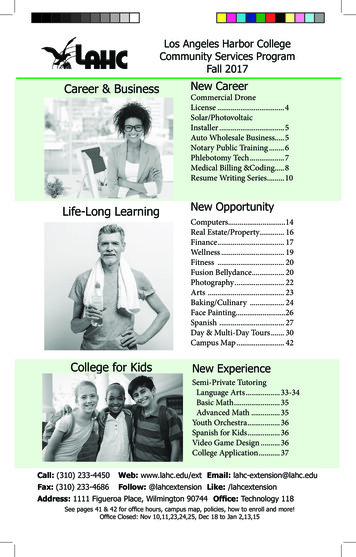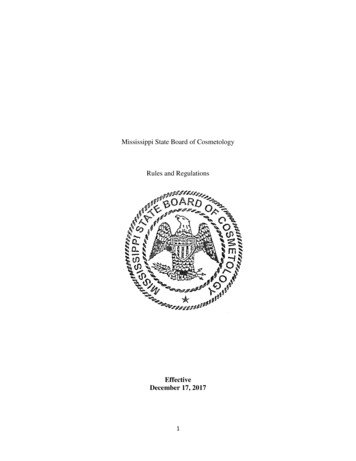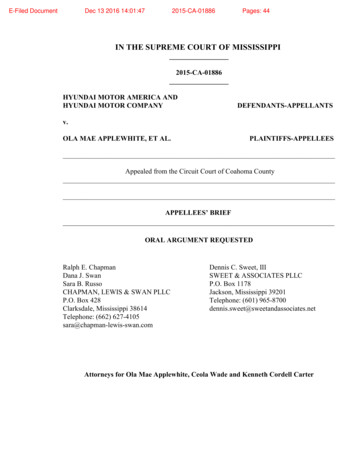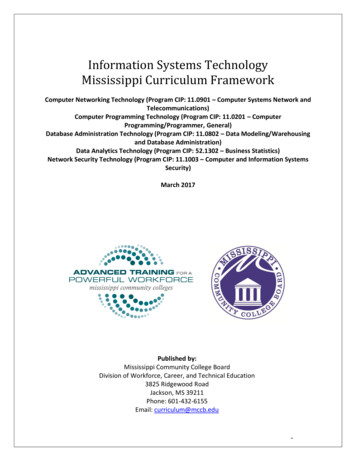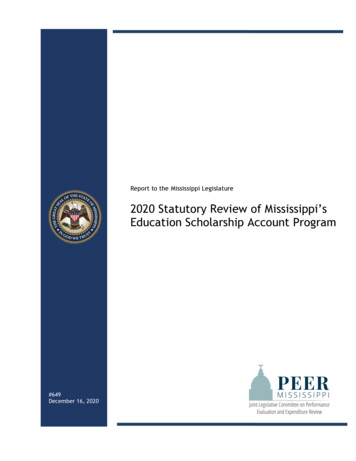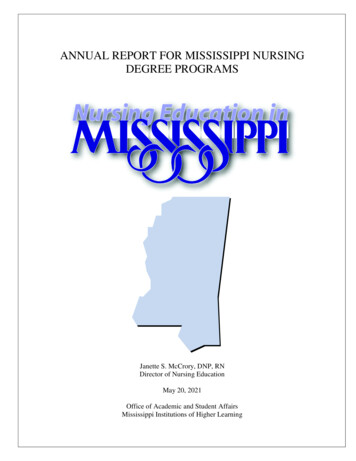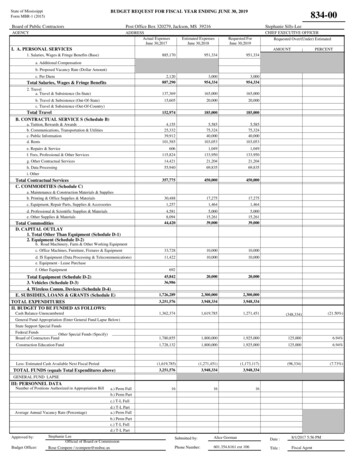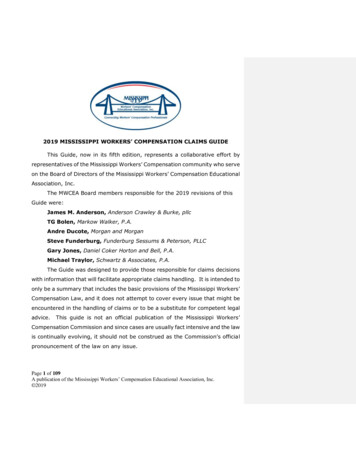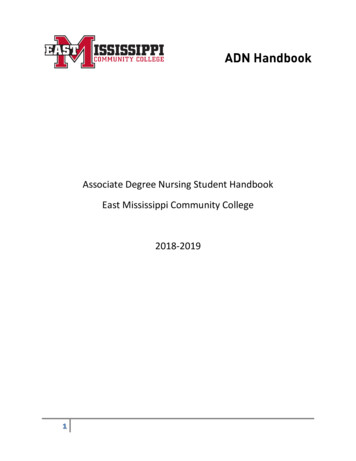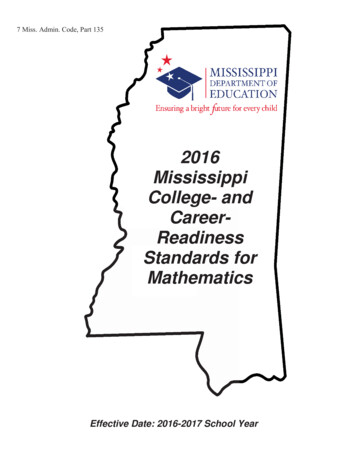
Transcription
7 Miss. Admin. Code, Part 1352016MississippiCollege- andCareerReadinessStandards forMathematicsEffective Date: 2016-2017 School Year
2016 Mississippi College- and Career-Readiness Standards for Mathematics2016 MississippiCollege- and Career-ReadinessStandards for MathematicsCarey M. Wright, Ed.D., State Superintendent of EducationKim S. Benton, Ed.D., Chief Academic OfficerJean Massey, Executive Director, Office of Secondary EducationNathan Oakley, Ph.D., Executive Director, Office of Elementary Education and ReadingTrecina Green, Executive Director, Office of Professional DevelopmentMarla Davis, Ph.D., NBCT, Bureau Director, Office of Secondary Education2
2016 Mississippi College- and Career-Readiness Standards for MathematicsMississippi Department of EducationPost Office Box 771Jackson, Mississippi39205-0771Office of Elementary Education and ReadingOffice of Secondary Education601-359-2586www.mde.k12.ms.us/ESEThe Mississippi State Board of Education, the Mississippi Department of Education, theMississippi School for the Arts, the Mississippi School for the Blind, the Mississippi School forthe Deaf, and the Mississippi School for Mathematics and Science do not discriminate on thebasis of race, sex, color, religion, national origin, age, or disability in the provision ofeducational programs and services or employment opportunities and benefits. The followingoffice has been designated to handle inquiries and complaints regarding the nondiscrimination policies of the above mentioned entities:Director, Office of Human ResourcesMississippi Department of Education3
2016 Mississippi College- and Career-Readiness Standards for MathematicsTable of ContentsIntroduction.5Acknowledgements .Error! Bookmark not defined.College- and Career-Readiness Standards for Mathematics Overview .9College- and Career-Readiness Standards for Mathematics Scaffolding Document .16College- and Career-Readiness Standards for Mathematics (Grades K-5).18Fluency/Fluently Defined .19Grade K .20Grade 1.25Grade 2.31Grade 3.36Grade 4.43Grade 5.51College- and Career-Readiness Standards for Mathematics (Grades 6-8) .58Grade 6.59Grade 7.67Grade 8.74Acceleration in Middle School.81Secondary Sequence Options .83High School Conceptual Categories.84Compacted Mathematics Grade 7 .94Compacted Mathematics Grade 8 (with Algebra I).104Compacted Mathematics Grade 8 (with Integrated Math I) .115College- and Career-Readiness Standards for Mathematics (Grades 9-12) .126Secondary Sequence Options .127High School Overview .128High School Conceptual Categories.129High School—Algebra I .140High School—Geometry .148High School—Algebra II .155High School—Integrated Mathematics I .165High School—Integrated Mathematics II .173High School—Integrated Mathematics III .182High School—Advanced Mathematics Plus .191High School—Algebra III .199High School—Calculus .204High School—SREB Math Ready.208High School—Advanced Placement (AP) Calculus.212High School—Advanced Placement (AP) Statistics .216Compensatory Mathematics Course Description .219Foundations of Algebra Course .220Glossary .225Tables .2334
2016 Mississippi College- and Career-Readiness Standards for MathematicsIntroductionMission StatementThe Mississippi Department of Education is dedicated to student success including theimprovement of student achievement in mathematics in order to produce citizens who arecapable of making complex decisions, solving complex problems, and communicatingfluently in a technological society. The 2016 Mississippi College- and Career-ReadinessStandards for Mathematics (“The Standards”) provide a consistent, clear understanding ofwhat students are expected to know and be able to do by the end of each grade level andcourse. The standards are designed to be robust and relevant to the real world, reflecting theknowledge and skills that students need for success in college and careers and to compete inthe global economy.PurposeIn an effort to closely align instruction for students who are progressing toward postsecondarystudy and the workforce, the 2016 Mississippi College- and Career-Readiness Standards forMathematics include grade- and course-specific standards for K-12 mathematics.The primary purpose of this document is to provide a basis for curriculum development forGrades K-12 mathematics teachers, outlining what students should know and be able to doby the end of each grade level and course. Courses for grades K-12 are based on theMississippi College- and Career-Readiness Standards (MS CCRS) for Mathematics.Mississippi-specific courses that were revised to align with the (MS CCRS) for Mathematicsinclude Pre-Calculus (renamed Algebra III) and Calculus.The Southern Regional Education Board (SREB) Math Ready course is included as atransition to college mathematics courses.The content of this document is centered on the mathematics domains of Counting andCardinality (Grade K), Operations and Algebraic Thinking; Numbers and Operations inBase Ten (Grades K-5); Numbers and Operations—Fractions(Grades 3-5); Measurement and Data (Grades K-5); Ratios and ProportionalRelationships (Grades 6-7); the Number System, Expressions & Equations, Geometry,Statistics & Probability (Grades 6-8); Functions (Grade 8), and the high school conceptualcategories of Number and Quantity, Algebra, Functions, Modeling, Geometry, andStatistics & Probability. Instruction in these domains and conceptual categories should bedesigned to expose students to experiences, which reflect the value of mathematics, toenhance students’ confidence in their ability to do mathematics, and to help studentscommunicate and reason mathematically.5
2016 Mississippi College- and Career-Readiness Standards for MathematicsImplementationThe required year for the 2016 Mississippi College- and Career-Readiness Standards forMathematics is school year 2016-2017.TechnologyThe Mississippi Department of Education (MDE) strongly encourages the use of technologyin all mathematics classrooms. Technology is essential in teaching and learningmathematics; it influences the mathematics that is taught and enhances students' learning.The appropriate use of instructional technology is integrated throughout the 2016Mississippi College- and Career-Readiness Standards for Mathematics. Teaching strategiesat each grade level and in every secondary course incorporate technology in the form ofcalculators, software, or on-line internet resources. The graphing calculator is an integralpart of mathematics courses beginning with Grade 6.The MDE believes strongly in the Principles and Standards for School MathematicsTechnology Principle of the National Council for Teachers of Mathematics (NCTM):“Calculators and computers are reshaping the mathematical landscape, and schoolmathematics should reflect those changes. Students can learn more mathematicsmore deeply with the appropriate and responsible use of technology. They canmake and test conjectures. They can work at higher levels of generalization orabstraction. In the mathematics classrooms envisioned in Principles andStandards, every student has access to technology to facilitate his or hermathematics learning. Technology also offers options for students with specialneeds. Some students may benefit from the more constrained and engaging tasksituations possible with computers. Students with physical challenges can becomemuch more engaged in mathematics using special technologies. Technologycannot replace the mathematics teacher, nor can it be used as a replacement forbasic understandings and intuitions. The teacher must make prudent decisionsabout when and how to use technology and should ensure that the technology isenhancing students' mathematical thinking.”(NCTM, 2013, http://www.nctm.org.)6
2016 Mississippi College- and Career-Readiness Standards for MathematicsAcknowledgementsCOMMITTEE MEMBERS (2015)The Mississippi Department of Education gratefully acknowledges the following individuals whoprovided feedback in developing the 2016 Mississippi College- and Career-ReadinessStandards for Mathematics.Christy BennettJennifer BennettSuzanne BreazealeStephanie BrewerShelita Brown, Ph.D.Libby CookKelli CrainMarla Davis, Ph.D.Donna DiazElizabeth FulmerCheryl HeavenerShauna HedgepethSidney Margaret Holbert, Ph.D.Leslie HollowayJessica Ivy, Ph.D.Suzanne JenningsCarol LadnerPatricia LampkinJoycelyn LorenzoSissy LynnMeredith "Paige" PhillipsAmie PowellKim PriceChetonia PryorDeia SandersKristen SchrimpshireAlice Steimle, Ph.D.Sharon SutherlinJennifer WilsonDeSoto County School DistrictCalhoun County School DistrictNeshoba CountyPetal Public School DistrictMississippi Department of EducationHinds County School DistrictMississippi Department of EducationMississippi Department of EducationBiloxi School DistrictMississippi Department of EducationSouth Tippah School DistrictLamar County School DistrictMississippi CollegePearl School DistrictMississippi State UniversityPascagoula-Gautier School DistrictMississippi Department of EducationHumphreys County School DistrictGulfport School DistrictMadison County School DistrictOcean Springs School DistrictMarion County School DistrictClinton School DistrictCoahoma AHS School DistrictSimpson County School DistrictQuitman School DistrictUniversity of MississippiBay-Waveland School DistrictRankin County School District7
2016 Mississippi College- and Career-Readiness Standards for MathematicsAcknowledgementsCOMMITTEE MEMBERS (2013)The Mississippi Department of Education gratefully acknowledges the following individuals whoprovided feedback in developing the 2015 Mississippi College- and Career-ReadinessStandards for Mathematics.Lisa AmackerRichard BalikoStephanie BrewerAngela CooleyTammi CrosettiMarla Davis, Ph.D.Melinda Gann, Ph.D.Roy GillTrecina GreenDavid Jay HerbertSusan Lee, Ed.D.JoAnn MaloneJean MasseyNathan OakleyKerri PippinJenny SimmonsAlice Steimle, Ph.D.LaVerne Ulmer, Ph.D.Jennifer WilsonPetal Public School DistrictMississippi Department of EducationPetal Public School DistrictJones County Junior CollegeRankin County School DistrictMississippi Department of EducationMississippi State UniversityHarrison County Public SchoolsMississippi Department of EducationDelta State UniversityInstitutions of Higher LearningMississippi Department of EducationMississippi Department of EducationMississippi Department of EducationJones County Junior CollegeLee County School DistrictUniversity of MississippiJones County Junior CollegeRankin County School District8
2016 Mississippi College- and Career-Readiness Standards for MathematicsCollege- and CareerReadiness Standards forMathematics Overview9
2016 Mississippi College- and Career-Readiness Standards for MathematicsCollege- and Career-Readiness Standards forMathematicsFor over a decade, research studies of mathematics education in high-performing countrieshave pointed to the conclusion that the mathematics curriculum in the United States mustbecome substantially more focused and coherent in order to improve mathematicsachievement in this country. To deliver on the promise of common standards, the standardsmust address the problem of a curriculum that is “a mile wide and an inch deep.” TheseStandards are a substantial answer to that challenge. Aiming for clarity and specificity, theseStandards endeavor to follow a design that not only stresses conceptual understanding ofkey ideas, but also by continually returning to organizing principles such as place value or thelaws of arithmetic to structure those ideas.Understanding MathematicsThese Standards define what students should understand and be able to do in their study ofmathematics. Asking a student to understand something means asking a teacher to assesswhether the student has understood it. But what does mathematical understanding look like?One hallmark of mathematical understanding is the ability to justify, in a way appropriate tothe student’s mathematical maturity, why a particular mathematical statement is true or wherea mathematical rule comes from. There is a world of difference between a student who cansummon a mnemonic device to expand a product such as (a b)(x y) and a student whocan explain where the mnemonic comes from. The student who can explain the ruleunderstands the mathematics, and may have a better chance to succeed at a less familiartask such as expanding (a b c)(x y). Mathematical understanding and procedural skillare equally important, and both are assessable using mathematical tasks of sufficientrichness.The Standards set grade-specific expectations but do not define the intervention methods ormaterials necessary to support students who are well below or well above grade-levelexpectations. It is also beyond the scope of the Standards to define the full range of supportsappropriate for English language learners and for students with special needs. At the sametime, all students must have the opportunity to learn and meet the same high standards ifthey are to access the knowledge and skills necessary for college and/or careers. TheStandards should be read as allowing for the widest possible range of students to participatefully from the outset, along with appropriate accommodations to ensure maximumparticipation of students with special education needs. For example, for students with readingdisabilities the use of Braille, screen reader technology, or other assistive devices should bemade available. In addition, while writing, these students should have access to a scribe,computer, or speech-to-text technology in their classroom. In a similar vein, speaking andlistening should be interpreted broadly to include sign language. No set of grade-specificstandards can fully reflect the great variety in abilities, needs, learning rates, andachievement levels of students in any given classroom. However, the Standards do provideclear signposts along the way to the goal of College- and Career-Readiness for all students.10
2016 Mississippi College- and Career-Readiness Standards for MathematicsStandards for Mathematical PracticeThe Standards for Mathematical Practice describe varieties of expertise that mathematicseducators at all levels should seek to develop in their students. These practices rest onimportant “processes and proficiencies” with longstanding importance in mathematicseducation. The first of these are the NCTM process standards of problem solving, reasoningand proof, communication, representation, and connections. The second are the strands ofmathematical proficiency specified in the National Research Council’s report Adding It Up:adaptive reasoning, strategic competence, conceptual understanding (comprehension ofmathematical concepts, operations and relations), procedural fluency (skill in carrying outprocedures flexibly, accurately, efficiently and appropriately), and productive disposition(habitual inclination to see mathematics as sensible, useful, and worthwhile, coupled with abelief in diligence and one’s own efficacy).1. Make sense of problems and persevere in solving them.Mathematically proficient students start by explaining to themselves the meaning of aproblem and looking for entry points to its solution. They analyze givens, constraints,relationships, and goals. They make conjectures about the form and meaning of the solutionand plan a solution pathway rather than simply jumping into a solution attempt. They consideranalogous problems, and try special cases and simpler forms of the original problem in orderto gain insight into its solution. They monitor and evaluate their progress and change courseif necessary. Older students might, depending on the context of the problem, transformalgebraic expressions or change the viewing window on their graphing calculator to get theinformation they need. Mathematically proficient students can explain correspondencesbetween equations, verbal descriptions, tables, and graphs or draw diagrams of importantfeatures and relationships, graph data, and search for regularity or trends. Younger studentsmight rely on using concrete objects or pictures to help conceptualize and solve a problem.Mathematical
Mississippi College- and Career-Readiness Standards (MS CCRS) for Mathematics. Mississippi-specific courses that were revised to align with the (MS CCRS) for Mathematics include Pre-Calculus (renamed Algebra III) and Calculus. TheSouthern Regional Education Board (SREB) Math Ready course is
